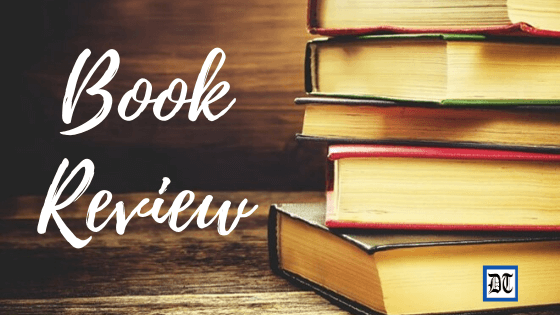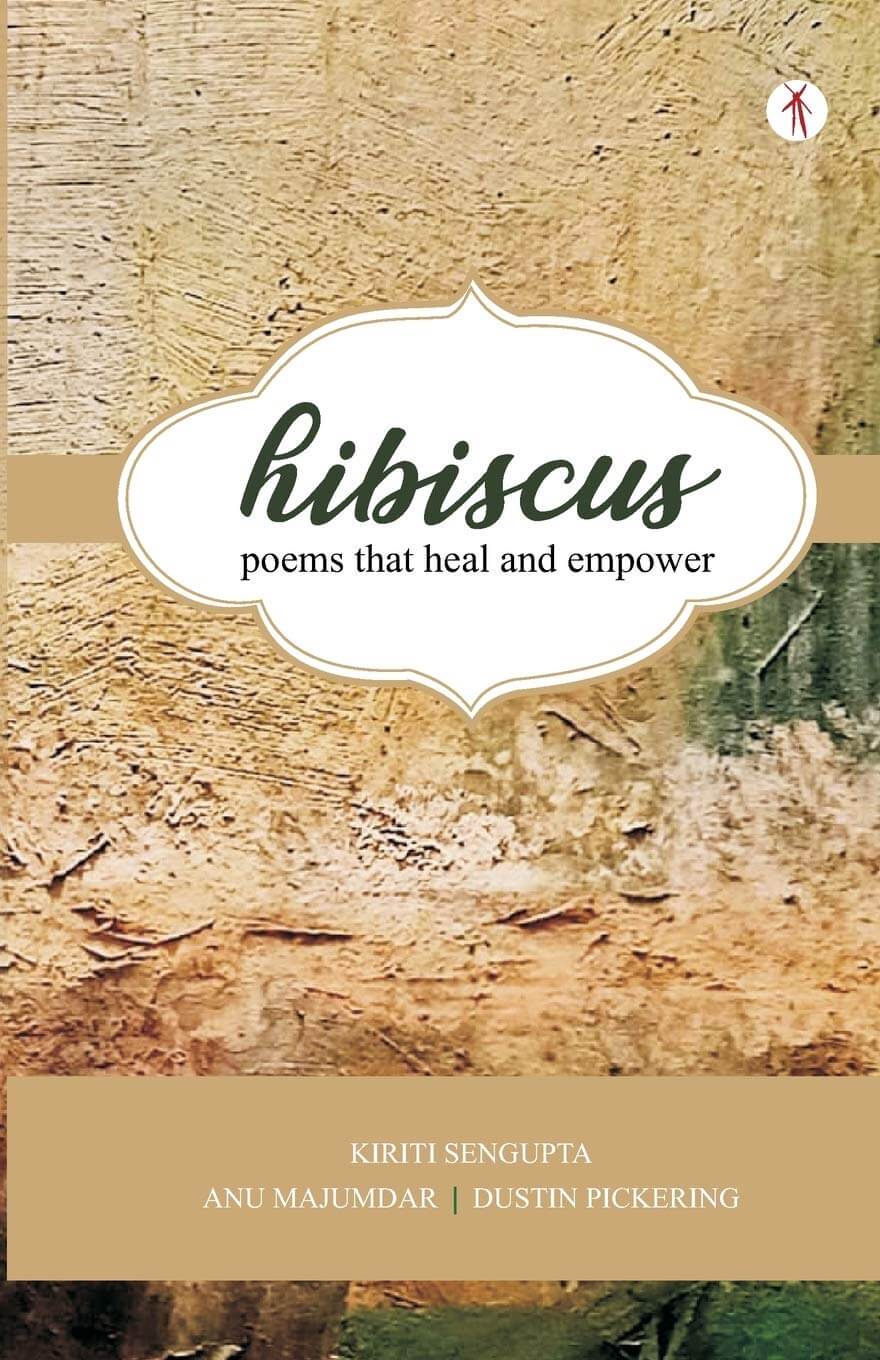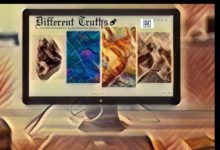Dustin’s contextual comments on Kiriti Sengupta’s freshly published work. He critiques and reviews Kirti’s works, ‘Shimmer Spring…’ and ‘Hibuscus…’, exclusively for Different Truths.

During the pandemic, publishing both slowed and became more relevant than ever. One Indian writer and editor, Kiriti Sengupta, maintained his journey despite the obstacles and lack of resources. His publishing concern with Bitan Chakraborty, Hawakal Publishers Private Limited (HPPL), grew and contributed new works with iconoclastic approaches to the world crises. Even as far-right-leaning ideology grew in strength and anti-Trump protest volumes filled the market, including lastbench little magazine’s special against the 45th president and numerous anthologies, Hawakal Publishers produced two books of import: Shimmer Spring, on enlightenment; and, Hibiscus, on healing. In addition, Illumination, an award-winning short documentary on Sengupta’s legacy, was released later in the pandemic.
The first sentence of the Hibiscus introduction states the matter unambiguously. “Empowerment precedes healing.” Sengupta discusses what this means from the angle of his former occupation, dentist. Hibiscus: poems that heal and empower was a market success as poetry volumes go, receiving critical acclaim and media attention. The volume’s relevance is vindicated in its popularity. A unique marketing approach followed the release. The editors used the Facebook platform to discuss three poems they favored from the collection, inviting all friends to participate. This participatory marketing of poetry was suggested by Sengupta himself to involve the public in a broad discussion of the world around them.
The first sentence of the Hibiscus introduction states the matter unambiguously. “Empowerment precedes healing.”
The world is a stage, and we are all players in it. The world and the mind are composed of the same materials and structured similarly. Sam Dresser writes for Aeon concerning fresh interpretations of Hegel:
Spirit is not some transcendent entity above and beyond the world. Neither is it simply identical to the material world. Rather, Spirit is identified with the social world and, especially, the normative structures that constitute human social interactions and, especially, human rationality. Such normative structures are necessarily embodied in material conditions and activities, but they cannot simply be identified with naturalistically (i.e., non-normatively) described activities of material bodies.
The preamble to Shimmer Spring, “Sublime Submissions,” summarises this philosophical principle in poetic patois: “How do we perceive light?…
The preamble to Shimmer Spring, “Sublime Submissions,” summarises this philosophical principle in poetic patois: “How do we perceive light? How do we intuit its source? It can be a cockcrow, it can be the candle we float in the river, it can reasonably be the lantern Ma placed at my study when there was a power cut, or it can well be literature that illumines our faculties.” Sengupta further writes, “Radiance liberates us from the murkiness.”
This principle suggests the mind is immense and is connected to the external world. Psychedelics were used in the ’60s to draw into the infinity. In Doors of Perception, Huxley writes, “Mind at large for every single one of us humans, is at each moment capable of remembering all that has ever happened to him and perceiving everything happening everywhere in the universe.” Neither internal nor external worlds are controlling or influencing the other. Instead, the “process” is in control. The dynamics and relations between them are not figurations but the determinants of behavior and its predictability.
The mind contains a gateway acting censor-like, comparable to Freud’s theory of the subconscious. Freud writes in Studies on Hysteria:
“The split, however, is rarely a clear-cut one. As a rule, portions of the subconscious complex of ideas intrude into the subject’s ordinary consciousness, and it is precisely they that provoke this kind of disturbance. What is usually perceived consciously, as in the instances I have quoted above, is the general feeling attached to the complex – a mood of anxiety, it may be, or of grief; and it is this feeling that, by a kind of ‘compulsion to associate,’ must have a connection found for it with some complex of ideas which is present in consciousness.”
It is Buddha’s nature to pursue it, but it is ultimately Nirvana. This gateway is a series of relations…
The immensity cannot be reached. It comes to you. It reflects on itself. It is Buddha’s nature to pursue it, but it is ultimately Nirvana. This gateway is a series of relations that induce motion and action on behalf of the Mind. This symbolism also is enacted in the external world. The movement causes heat and is the sexual energy we experience. Hence, the world is an illusion in the sense that it contains nothing different than the mind. The Shadow must be integrated — “Othering” is a projection related to one’s significant desires. Desire is often mimetic, which proves the unity of desire within the process. Freudian “defense mechanisms” outsource the logic of desire. Shadow work is integration, self-actualization. The Mind comes closer when knowledge is unraveled. Hence, the struggle for meaning. Viktor Frankl writes in Man’s Search for Meaning:
Ultimately, man should not ask what the meaning of his life is but rather must recognize that it is he who is asked. In a word, each man is questioned by life, and he can only answer to life by answering for his own life; to life he can only respond by being responsible.
Poet Kiriti Sengupta offers a unique approach to the fundamental expression of truth. His work seemingly casts his person aside while flagging fissures of reality. In “Line of Control,” the poet writes:
My stroll to the cha shop is routinely challenged.
Curs from the neighborhood march along.
Affray crams the air.
The dogs are the narrator’s fixation. The “affray” that “crams the air” distracts him.

The dogs are the narrator’s fixation. The “affray” that “crams the air” distracts him. The dogs are a compulsive nuisance in the poem. The poet recognizes that his visit for tea is challenged daily by the “line of control” the curs offer. Here there is a sense that the poet wants to be in control of the totality — absolute freedom of mind, but the continuous presence of mutts intensifies the stroll. The animals are archetypal fixations of the Mind to gauze the inevitable fear of abandoning oneself to the Mind. The Mind is thirsty as it ambulates toward the teahouse; its relations to the Real are agitated energies dispersing and secretly desiring control, hence the association of the animals with the “line of control.” The teahouse gatherers feed some of the street dogs to appease them, and the rival dogs howl and fight over the scraps. These relations under the poet’s nose are observed through the Mind quietly, although the poet is the conduit of the phenomenon in his observations.
“Cryptic idiom,” a term coined to describe Sengupta’s phraseology, means the statements themselves do not relinquish their content. Readers do not relate to the words because they are enigmas. Nothing can be drawn from them. The reader cannot feel awe or beauty — “top of the head taken off,” as Dickinson remarked — because the immensity of Mind is balanced within the context. The idioms are places and situations in themselves and not relations or statements of purpose. Essentially each fragmented enigma is a room one enters only to find it conjoined with the next. The rooms are not even interconnected but somehow maintain unity within the stretch of the poem itself. In the verse mentioned above, the tranquility of Mind is lost and sought as the familiar street dogs are met with the frequent followers of the poet from elsewhere. This suggests a meeting between the everyday situations with the intrusive bearings of the poet’s walk, which frequently brings the straggling dogs in contact with the regular mutts of the teahouse.
Poetry is the making and shaping of culture. Culture is a voice with pitch and tone.
Poetry is the making and shaping of culture. Culture is a voice with pitch and tone. It communicates as a signal. Fluctuations are constant. Wavelengths are dictated by voltage. There are hidden Markov signals within the “voice.” “Voice” is a slang term in the creative writing community to describe one’s writing style. It includes what is communicated and how, but it is often not clear what it means. To “find your own voice” is to be nestled within poetry itself.
Dominant culture and relations are Markov chains where stochastic processes are held to contingencies. Subcultures are hidden Markov signals that emerge within the chain to disrupt. As with Godel’s Incompleteness Theorem, some axioms are improvable within the system for a complete system, and to prove the hypothesis, one must create a new method of logic. The new system will confirm the original set. However, this proving of axioms may be continuous.
Throughout an “information system” — a culture — dominant axioms in the chain follow a definite line.
Similarly, the hidden Markov system (i.e., subcultures) couched within the Markov signal chain fills the gaps where statistical probabilities are uncertain. Throughout an “information system” — a culture — dominant axioms in the chain follow a definite line. As voice, culture has a predetermined wavelength based on its voltage (or compressed units of force). Pitch is the height of the wavelength, and tone is the shaping of it. The polar interactions of dominant culture/subculture create what we know as history. Culture is a record of events and processes.
In Sengupta’s poem “Boris Johnson in Isolation,” we are confined with Johnson through the poet’s furious remarks. The system is disrupted, and Sengupta writes:
Resources pledge welfare,
as quarantine breaks sequence.
Doesn’t inanition evade all control?
Why wouldn’t welfare pledge resources? This twist in order reminds us that resources come first. The order of things is secondary to how that order is achieved. The disruption, a break in the Markov chain, is inane — the poet is angry that even influential leaders do not control the subtle forces confining us. Such situations parody their arrogance. Quarantine is a total chasm in our social relations. It elicits no pity. The previous two lines bear this fury with historical grace: “famine is meatier than the virus. / Religion spawns decimation.” As religion’s popularity declines worldwide, we are still facing the hopelessness of moral ambivalence. Why isn’t world hunger a priority, ever? If the fawning leaders can factor with The Great Reset in so much haste, why couldn’t they mobilize us to feed the planet’s starving children? Colonialism is a deathly history; it is the pandemic of years prior. Religion was imposed on entire continents while resources were siphoned for power and greed. Colonialism’s legacy lives, and we reckon with it. Medical and environmental science uncovers the problems of this legacy and its impact on marginalised communities. The pandemic offers time for reflection and reevaluation. Intense interrogations posed are the “chickens come home to roost” from a brutal legacy, rising to reshape our destiny.
Once the dominant culture incorporates the subcultures, it gradually shifts to the decadent catastrophic phase.
Once the dominant culture incorporates the subcultures, it gradually shifts to the decadent catastrophic phase. Sudden shifts occur once the envelope is pushed so that polarities are no longer acknowledged—all signifiers become empty. The world is no longer taken seriously. It becomes the project of a mad trickster. The subcultures once were voices of disillusion and repressed energies. These subcultures, once mainstreamed, thicken the information flow and slow it until such decadence destroys the entire circuit. Thus, consciousness even suffers. It can no longer interrogate reality. Instead, it pimps and whines.
The Author as Spirit recalls the work itself as analogous to the Markov chain and the relations predating consciousness. Archetypes that signify reality redeem it from its bastardisation. Moral ambiguity is the key result of decadent taboo-breaking. These taboos are sanctified by their primordial energies and content. In Totem and Taboo, Freud writes:
The difference is related to the fact that taboos still exist among us … They do not differ in their psychological nature from Kant‘s ‘categorical imperative,’ which operates in a compulsive fashion and rejects any conscious motives.
To unravel them is to unleash tremendous energies. Essentially, once the taboos are curtailed by subcultures becoming mainstream, there are no standards left to grant the illusion of order. Moral ambiguity becomes continuous chaos and renaissance.
The Author redeems the world by recreating the text and placing it in contextual balance.
The Author redeems the world by recreating the text and placing it in contextual balance.
In “Lucency,” Sengupta conditions colors with these very ideas. I present the prose poem in its entirety.
Lucency
I have a reason to suspect the vision when they say it is a kaleidoscopic world. Is it color deficiency? Textbook suggests: inadequacy lies with the cone cells. I doubt how many colors they can see! Does the earth become polychromatic only by envisioning a color or two? Then, why do we call it a red rose? We could have said it a variegated blossom. Why do we refer to coal as black? Coal is psychedelic, rather! What about “milky white?” Milk is rainbow; correct me if I’m not right. How many hues have you envisaged so far? I ask about the hues but not your bizarre way of depicting them. I figure out the similarities and differences between color and queerness. I also assess the tints of your eccentricity. They are red, yellow or blue. I’m aware human beings, with all their strangeness, point at their feelings to describe colors. Laughter-wail-jealousy, grief, and joy: what are paints barring these sentiments? How can one describe the earth as varicolored? Let me ask: what is the color of deafness? How will you tinge a mute tree? Can you stain dumbness in any tint? Is clot the only color to portray the wounded genital of a woman? Does it not have a male filth? The lesion also marks tears. You know, water is achromic and otherwise called life!
Here taboo is put on the edge of the iceberg. The final lines instill uncomfortable ideas in the reader. A wounded woman after a natural sexual encounter is followed immediately by dialectic aimed at the poem itself. The last line, “water is achromic and otherwise called life!” breaches a mystery the poet never thoroughly explains. The poem seems to celebrate a variegated beauty, but it is ultimately a question concerning the poetic rendering of such beauty. Contemplation is pure water, translucent, and not hued or kaleidoscopic. Medical science offers a reason the visionaries discuss a kind of peacock-vision: “inadequacy lies with the cone cells.” There is a temperamental need in poets to escape the physical world and its intense logic into a realm of phosphenes. “Lucency” offers the idea that the world is transparent and fluid, not rainbow-hued. This idea asserts the World Spirit’s motions rather than a mythical tripe vision.
We are freed from the Romantic Age. Postmodernism is declining in relevant criticism.
We are freed from the Romantic Age. Postmodernism is declining in relevant criticism. Nevertheless, poets such as Kiriti Sengupta invite fresh soil for our journeys. He says candidly, in the documentary Illumination, “Poetry is perhaps that mark which never dies.” After defining the age’s varied approaches to poetic creation, Sengupta says finally, “Poetry is only me. I am poetry.” Indeed.
Sources:
1. Sengupta, Kiriti, et al., editors. Hibiscus: poems that heal and empower. Kolkata: Hawakal Publishers, 2020.
2. Dresser, Sam. “Hegel Today.” Aeon. October 26, 2021. https://aeon.co/essays/how-the-anglophone-world-is-rediscovering-hegels-philosophy
3. Sengupta, Kiriti, editor. Shimmer Spring. Kolkata: Hawakal Publishers, 2020.
4. Huxley, Aldous. The Doors of Perception. New York City: Vintage Books, 1954.
5. Breuer, Joseph and Freud, Sigmund. Studies on Hysteria. New York: Basic Books and Publishers, 1895.
6. Frankl, Viktor. Man’s Search for Meaning. Boston: Beacon Press, 1980.
7. Sengupta, Kiriti. “Line of Control.” The Lake. September 2021. http://www.thelakepoetry.co.uk/poetry/kiriti-sengupta/
8. Sengupta, Kiriti.“Boris Johnson in Isolation.” The Lake. September 2021. http://www.thelakepoetry.co.uk/poetry/kiriti-sengupta/
9. Freud, Sigmund. Totem and Taboo: Resemblances Between the Mental Lives of Savages and Neurotics. New York City: Moffet, Yard and Company, 1919.
10. Sengupta, Kiriti. “Lucency.” Café Dissensus. August 7, 2020. https://cafedissensuseveryday.com/2020/08/07/four-poems-by-kiriti-sengupta/
11. Bhowmik, Promita, director. Illumination: exploring the works of Kiriti Sengupta. CLASSIX, 2021.20 minutes. https://www.youtube.com/watch?v=EPqkhed29XI&t=809s
Book Covers from the Internet





 By
By

 By
By
 By
By